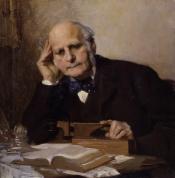The Return of Eugenics
By Fraser Nelson,
The Spectator [UK]
| 04. 02. 2016
Untitled Document
The only way of cutting off the constant stream of idiots and imbeciles and feeble-minded persons who help to fill our prisons and workhouses, reformatories, and asylums is to prevent those who are known to be mentally defective from producing offspring. Undoubtedly the best way of doing this is to place these defectives under control. Even if this were a hardship to the individual it would be necessary for the sake of protecting the race.
— The Spectator, 25 May 1912
It’s comforting now to think of eugenics as an evil that sprang from the blackness of Nazi hearts. We’re familiar with the argument: some men are born great, some as weaklings, and both pass the traits on to their children. So to improve society, the logic goes, we must encourage the best to breed and do what we can to stop the stupid, sick and malign from passing on their defective genes. This was taken to a genocidal extreme by Hitler, but the intellectual foundations were laid in England. And the idea is now making a...
Related Articles
By Abby McCloskey, The Dallas Morning News | 10.10.2025
We Texans like to do things our way — leave some hide on the fence rather than stay corralled, as goes a line in Wallace O. Chariton’s Texas dictionary This Dog’ll Hunt. Lately, I’ve been wondering what this ethos...
Paula Amato & Shoukhrat Mitalipov
[OHSU News/Christine Torres Hicks]
On September 30th, a team of 21 scientists from Oregon Health & Science University (OHSU) published a significant paper in Nature Communications, with a scientifically accurate but, to many, somewhat abstruse headline:
Induction of experimental cell division to generate cells with reduced chromosome ploidy
The lead authors were Shoukhrat Mitalipov, recently described here as “a push-the-envelope biologist,” and his long-term colleague Paula Amato. (Recall that in July the pair had co-published with...
By Julia Black, MIT Technology Review | 10.16.2025
Consider, if you will, the translucent blob in the eye of a microscope: a human blastocyst, the biological specimen that emerges just five days or so after a fateful encounter between egg and sperm. This bundle of cells, about the size of...
By Lizzy Lawrence, Stat News | 10.14.2025




